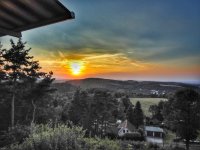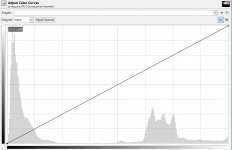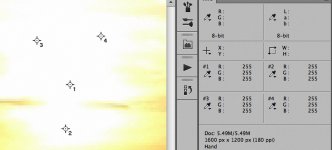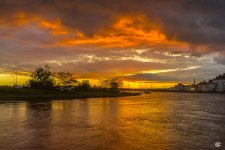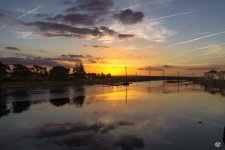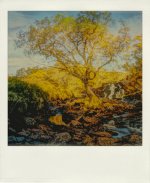Clipped highlights. Unrecoverable. Goes straight to the trash.
You’re right, I have a thing about clipped highlights and blocked shadows, so here is a (somewhat cheesy) compromise:-
Attachments
Yeah, however there is no connection between audio and photography.
Is that in the literal sense?
Clipped highlights. Unrecoverable. Goes straight to the trash.
You’re right, I have a thing about clipped highlights and blocked shadows, so here is a (somewhat cheesy) compromise:-
And you are sure guys.
Attachments
T., ToS, photography is about artistic expression, it is an art. Sound reproduction has to reproduce recorded sound as perfect as possible, just to make an amplified version without modifications, it is an engineering. Modifications to be made by a mastering engineer. He is a "photographer", amplifier or DAC is not. You are totally wrong with your analogy and you are missing the basic premise of sound reproduction.
Last edited:
Dan, I did not laugh at you. I was asking a serious question. For you to think about. A question I always ask to myself first.T, you can jest all you like at what I describe, gold and silver are not the only sonic 'flavourings' available.
I can rephrase-it using your image and what is taught by all the great cooking chiefs. Do you think playing with unknown spices rather than the quality of the products themselves is the best way to make a great recipe ?
When those chiefs use thin gold foils, it is just to change the look of their plate, not the taste.
As we are situated on each side of the planet from each other, I have no way to evaluate by myself the effectiveness of your original approach. It should be as stupid to reject-it than to believe in it.
That being said, if you put yourself in my place, you will grant me the right, among other hypotheses, to imagine that all this could be the product of a delusional imagination ?
So, can-you provide-me a simple way to experiment one of your revolutionary discoveries ? I was not convinced by your previous comparative tests.
On my side, I use several tools to modify the sounds qualities, frequency correctors, compressors, expander, noise gates, artificial reverbs, delays and flanges etc.
Lot of people use them, they have demonstrated their efficiency. But it is more about "cooking" than spicing. And the quality of the product is the musician part.
With all due respect.
And you are sure guys.
PMA,
What you are looking at there is a straight logarithmic tone curve, which is the bane of digital light capture. The curve would need a shoulder, a tummy and a boot to make something out of it - but - if it ain’t there then what you get is noise and distortion in the same way if bass, mids and treble are applied as eq to a poor quality recording of sound. Also, as the extremes of highlights and shadows are clipped out from the sensor before being rendered in camera as a RAW file, then the workable solution is by averaging out from multiple exposures to get an acceptable result, or to employ the use of HDR, either as tone mapping (as shown in my crude example) or full on multiple exposure bracketing.
The analogous comparisons between audio and photography are simply too numerous to mention.

ToS
Never mind the compressed dynamic range of printing, which obviates the argument about the hard limits of digital cameras versus the soft highlight shoulder on film.
The applicable dynamic range and ability to stretch and compress luminosity data on a modern camera, ESPECIALLY when we use print as our media, is great. The story doesn't really change much on a high DR screen either.
Old sunsets on film weren't great either. Nice having the ability to expose for the sun and dig out the shadows. Doubly so if you know how to bin a few replicates to clean up the noise in the deep shadows. Never been a better time to be a photographer, in a technical sense. The business of photography is a different story.
Anyways all the talk about ignore lists and leaving threads is childish and for drama. If exiting or filtering the people you read was the goal, one would just do it and move on without fanfare.
The applicable dynamic range and ability to stretch and compress luminosity data on a modern camera, ESPECIALLY when we use print as our media, is great. The story doesn't really change much on a high DR screen either.
Old sunsets on film weren't great either. Nice having the ability to expose for the sun and dig out the shadows. Doubly so if you know how to bin a few replicates to clean up the noise in the deep shadows. Never been a better time to be a photographer, in a technical sense. The business of photography is a different story.
Anyways all the talk about ignore lists and leaving threads is childish and for drama. If exiting or filtering the people you read was the goal, one would just do it and move on without fanfare.
Last edited:
Yes! And, as you so often like to point to others - please learn to use the measurement tools. Or adjustment tools, for that matter.And you are sure guys.
Attachments
T., ToS, photography is about artistic expression, it is an art. Sound reproduction has to reproduce recorded sound as perfect as possible, just to make an amplified version without modifications, it is an engineering. Modifications to be made by a mastering engineer. He is a "photographer", amplifier or DAC is not. You are totally wrong with your analogy and you are missing the basic premise of sound reproduction.
Home audio gear is just the printer. The camera is the recording studio, photoshop is the mixing/ mastering studios. So what kind of printer do you want, one that recreates the image exactly or one that makes the images "better"? From what I see hear, the subjectivists want the latter, and they are just guessing.
You’re right, I have a thing about clipped highlights and blocked shadows, so here is a (somewhat cheesy) compromise:-
Looks like a homomorphic filter.
Ok, my answer (see attached), highly non linear, thanks to lightroom. Closer to real experience than your, don't you think ? And still far from the impossible reality, despite all my efforts.OK - no Photoshop used.
And, yes i believe there is a lot of equivalences between Photography and Audio. Too lazy to list them. And too obvious.
Back to your old demons ("I will show-you the way !")?You are totally wrong with your analogy and you are missing the basic premise of sound reproduction.
Attachments
Last edited:
T., ToS, photography is about artistic expression, it is an art. Sound reproduction has to reproduce recorded sound as perfect as possible, just to make an amplified version without modifications, it is an engineering. Modifications to be made by a mastering engineer. He is a "photographer", amplifier or DAC is not. You are totally wrong with your analogy and you are missing the basic premise of sound reproduction.
OK Pavel, I am amenable to agree to disagree, but I can assure you that my technical training in photography is the equal of your undoubted ability as a audio recording engineer. Thus, my analogy (however crude and poorly written) has the ring of truth about it.
 ToS
ToSLooks like a homomorphic filter.
You are right - just something I quickly cobbled together in SnapSeed

Attached is a standard speech intelligibility test file.
You will need a pencil and paper when you listen to this. There are 50 test words. Just write down what you hear. After a few folks confirm they have done this I will show the word list.
BTY spelling does not count. So if the test word is "Jerk" and you spell it Jyrk" that counts as right. If you think it is "Zerk" that is wrong.
You can use headphones or near field loudspeakers and try out your hearing abilities or your actual sound system and include room effects.
You will need a pencil and paper when you listen to this. There are 50 test words. Just write down what you hear. After a few folks confirm they have done this I will show the word list.
BTY spelling does not count. So if the test word is "Jerk" and you spell it Jyrk" that counts as right. If you think it is "Zerk" that is wrong.
You can use headphones or near field loudspeakers and try out your hearing abilities or your actual sound system and include room effects.
Attachments
Last edited:
Old sunsets on film weren't great either. Nice having the ability to expose for the sun and dig out the shadows. Doubly so if you know how to bin a few replicates to clean up the noise in the deep shadows. Never been a better time to be a photographer, in a technical sense.
Daniel,
Not quite ...... if I wish to, I can shoot a sunset, or any other high contrast scene on slow colour negative film by overexposing by 5 to 6 stops and scanning the neg.
You get compression in the highlights and the shadows come through, analogous with audio compression by using fast moving magnetic tape recording a loud signal.

ToS
Big sensor helps digital to handle contrasts as well. Not the smallish like 1/2.3" shown here. However, nonsense analogy with audio again. No vinyl or tape has dynamic range of 24 bit audio. And no tricks with underexposure would help the vinyl or tape get more. Dolby? High dynamic classical music is uncapturable with analog.
Last edited:
Never mind the compressed dynamic range of printing, which obviates the argument about the hard limits of digital cameras versus the soft highlight shoulder on film.
The applicable dynamic range and ability to stretch and compress luminosity data on a modern camera, ESPECIALLY when we use print as our media, is great. The story doesn't really change much on a high DR screen either.
I have a Sony medical reference display in my office and it is relatively unimpressive for the ~$30k it costs
Is there an English version?Attached is a standard speech intelligibility test file.
ToS, no underestimating of your photo skills. But this is an audio forum and my point is that any analogy between photography and sound reproduction is a nonsense. BTW, do you have a photography web page, exhibitions? I will certainly be interested.
PMA,
OK kiddo, I’m good with that, and I ain’t here to troll. At the moment I don’t (by choice!) have a photographic website. My professional whoring days are long gone, and if I put up the work I am doing now, it will be appropriated in an instant. I am going to have my first one man show next year of massive pieces, in fact I am sitting here in front of my computer writing quips for diyAudio while ‘The Beast’ is pixel crunching.
But in the meantime, here is something throwaway-nice to look at.
ToS
Attachments
- Status
- Not open for further replies.
- Home
- Member Areas
- The Lounge
- John Curl's Blowtorch preamplifier part III
